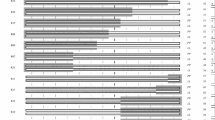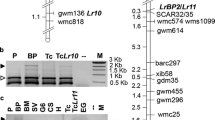Summary
Resistance to race 3 of Fusarium wilt in the wild tomato Lycopersicon pennellii (LA 716) was previously found to be controlled by one major locus, I-3, tightly linked to Got-2 on chromosome 7. This accession was also found to carry resistance to races 1 and 2; a genetic analysis of these resistances is reported in this paper. This analysis proceeded in two steps. First, allelism tests demonstrated that race 1 and 2 resistances carried by L. pennellii were not allelic to the I and I-2 genes originally incorporated into L. esculentum from L. pimpinellifolium. Second, an interspecific backcross with L. pennellii (BC1) was used to determine the mode of inheritance of these new resistances and their chromosomal location by segregation and linkage analysis. BC1 responses to each of the races were determined using progeny tests (BC1S1). BC1S1 plants were inoculated with race 1 or 2 and evaluated after 1 month using a visual disease rating system; mean disease ratings were calculated for each BC1 individual for each race based on the progeny scores. A bimodal frequency distribution of the BC1 mean disease ratings was observed for both races, indicating that one major locus controlled resistance in each case. Statistical comparisons of the mean disease ratings of homozygous versus heterozygous individuals at each of 17 segregating enzyme loci were used to map the resistances to races 1 and 2. Tight linkage was detected between the enzyme locus Got-2 and resistances to both races, as was previously reported for the I-3 locus. Therefore, the Got-2 locus can be used as a selectable marker for resistances to all three races. The relationship of these resistances is discussed in the paper. In addition, as previously reported for race 3, significance was also detected for the chromosome segment marked by Aps-2 on chromosome 8 for both races. Currently many cultivars carry I and I-2 resistances to races 1 and 2. Incorporation of the LA 716 resistances to these two races into cultivars may reduce the likelihood of new race development.
Similar content being viewed by others
References
Alexander LJ, Hoover MM (1955) Disease resistance in wild species of tomato. Ohio Agr Exp Stn Res Bull 752:1–76
Anikster Y, Wahl I (1979) Coevolution of the rust fungi on Gramineae and Liliaceae and their hosts. Annu Rev Phytopathol 17:367–403
Bohn GW, Tucker CM (1939) Immunity to Fusarium wilt in the tomato. Science 89:603–604
Bohn GW, Tucker CM (1940) Studies on Fusarium wilt of the tomato. I. Immunity in Lycopersiconpimpinellifolium and its inheritance in hybrids. Mo Agr Exp Stn Res Bull 311:1–82
Bournival BL, Vallejos CE, Scott JW (1988) Two new enzyme loci for chromosome 1. Rep Tomato Genet Coop 38:10–11
Bournival BL, Scott JW, Vallejos CE (1989) An isozyme marker for resistance to race 3 of Fusarium oxysporum f. sp. lycopersici in tomato. Theor Appl Genet 78:489–494
Chetelat RT (1989) Isozyme gene linkage map of tomato (Lycopersicon esculentum). Isozyme Bull 22:19
Davis RM, Kimble KA, Farrar JJ (1988) A third race of Fusarium oxysporum f. sp. lycopersici identified in California. Plant Dis 72:453
Eshed N, Dinoor A (1981) Genetics of pathogenicity on Puccinia coronata: the host range among grasses. Phytopathol 71:156–163
Grattidge R, O'Brien RG (1982) Occurrence of a third race of Fusarium wilt of tomatoes in Queensland. Plant Dis 66:165–166
Latterot H (1976) Mapping of I-2 allele in tomato, controlling the genetic resistance to pathotype 2 of Fusarium oxypsorum f. sp. lycopersici wilt. Ann Amelior Plant 26:485–491
Moseman JG, Nevo E, Zohary D (1983) Resistance of Hordeum spontaneum collected in Israel to infection with Erysiphe graminis hordei. Crop Sci 23:1115–1119
Moseman JG, Nevo E, El Morshidy MA, Zohary D (1984) Resistance of Triticum dicoccoides to infection with Erysiphe graminis tritici. Euphytica 33:41–47
Paddock EF (1950) A tentative assignment of the Fusarium-immunity locus to linkage group 5 in tomato. Genetics 35:683–684
Rick CM, Tanksley SD (1981) Genetic variation in Solanum pennellii: comparisons with two other sympatric tomato species. Plant Syst Evol 139:11–45
Scott JW, Jones JP (1989) Monogenic resistance in tomato to Fusarium oxysporum f. sp. lycopersici race 3. Euphytica 40:49–53
Stall RE, Walter JM (1965) Selection and inheritance of resistance in tomato to isolates of races 1 and 2 of the Fusarium wilt organism. Phytopathology 55:1213–1215
Tanksley SD, Rick CM (1980) Isozymic gene linkage map of the tomato: applications in genetics and breeding. Theor Appl Genet 57:161–170
Volin RB, Jones JP (1982) A new race of Fusarium wilt of tomato in Florida and sources of resistance. Proc Fla State Hort Soc 95:268–270
Author information
Authors and Affiliations
Additional information
Communicated by F. Salamini
Florida Agricultural Experiment Station, Journal Series No. R-00205
Rights and permissions
About this article
Cite this article
Bournival, B.L., Vallejos, C.E. & Scott, J.W. Genetic analysis of resistances to races 1 and 2 of Fusarium oxysporum f. sp. lycopersici from the wild tomato Lycopersicon pennellii . Theoret. Appl. Genetics 79, 641–645 (1990). https://doi.org/10.1007/BF00226877
Received:
Accepted:
Issue Date:
DOI: https://doi.org/10.1007/BF00226877




